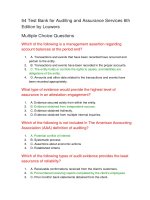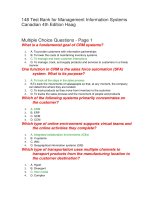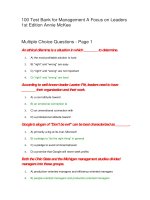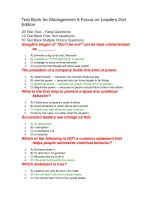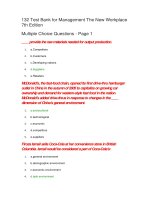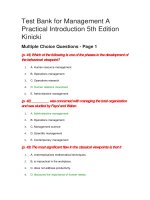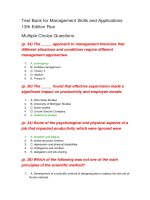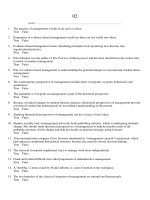140 test bank for management a practical introduction 6th edition by kinicki
Bạn đang xem bản rút gọn của tài liệu. Xem và tải ngay bản đầy đủ của tài liệu tại đây (202.08 KB, 39 trang )
Test Bank for Management A Practical Introduction 6th
Edition by Kinicki
62 Test Bank f True – False Questions
9 Test Bank Free Text Questions
69 Test Bank Multiple Choice Questions
Taylor called the tendency for people to deliberately work at less than full
capacity
1.
A. loafing.
2.
B. underachieving.
3.
C. underperforming.
4.
D. therbliging.
5.
E. soldiering.
Behavioral science relies on __________ for developing theories about
human behavior that can help managers.
1.
A. rules of thumb
2.
B. scientific research
3.
C. intuition
4.
D. simulations
5.
E. trial and error
McDonald's ability to deliver food quickly and inexpensively has its roots in
which management theory?
1.
A. Management science viewpoint
2.
B. Behavioral viewpoint
3.
C. Mathematical viewpoint
4.
D. Systems viewpoint
5.
E. Classical viewpoint
Among the recommendations of Mary Parker Follett was that
1.
A. motion studies should be made of every job.
2.
B. managers should design and control the work process.
3.
C. integration should occur in organizations when conflicts arise.
4.
D. a competitive environment is most conducive to productivity.
5.
E. everyone should understand their roles: managers as order-givers, and
employees as order-takers.
Scientific and administrative management are part of the ________
viewpoint.
1.
A. behavioral
2.
B. contingency
3.
C. classical
4.
D. quantitative
5.
E. quality
Which of the following was a positive feature of bureaucracy, according to
Max Weber?
1.
A. Generalists in the workplace.
2.
B. A flat organization with little hierarchy of authority.
3.
C. Hiring and promotion based on social status.
4.
D. Clear division of labor.
5.
E. Flexible rules and procedures.
Of the following, which is one of the functions of management described by
Fayol?
1.
A. Accommodating
2.
B. Coordinating
3.
C. Arbitrating
4.
D. Collaborating
5.
E. Tasking
Who proposed the hierarchy of human needs as a theory of motivation?
1.
A. McGregor
2.
B. Weber
3.
C. Munsterberg
4.
D. Maslow
5.
E. Mayo
________ management means translating principles based on best
evidence into organizational practice, bringing rationality to the decisionmaking process.
1.
A. Total quality
2.
B. Operations
3.
C. Administrative
4.
D. Evidence-based
5.
E. Scientific
Which of the following is a discipline that is part of behavioral science?
1.
A. Sociology
2.
B. Physics
3.
C. Computer science
4.
D. Biology
5.
E. Law
"True is better than new" is one of the truths of
1.
A. scientific management.
2.
B. the human relations movement.
3.
C. operations management.
4.
D. evidence-based management.
5.
E. management science.
Classical, behavioral, and quantitative viewpoints about management are
collectively referred to as the ________ perspective.
1.
A. historical
2.
B. scientific
3.
C. operations
4.
D. contemporary
5.
E. systems
The most significant flaw in the classical viewpoint is that it
1.
A. overemphasizes mathematical techniques.
2.
B. is impractical in the workplace.
3.
C. does not address productivity.
4.
D. discounts the importance of human needs.
5.
E. does not account for irrational behavior.
Camille runs a consulting business that assists in the hiring process, using
a team of psychologists to help companies to better understand their
specific jobs and the type of employees that are best suited to fill them. Her
business relies on the work of which behavioral theory pioneer?
1.
A. Hugo Munsterberg
2.
B. Douglas McGregor
3.
C. Mary Parker Follett
4.
D. Frederick Taylor
5.
E. Elton Mayo
Which of the following is not one of the principles proposed by Fredrick
Taylor to eliminate soldiering?
1.
A. Give workers the training and incentives to do the task properly.
2.
B. Carefully select workers with the right abilities for the task.
3.
C. Study each part of the task scientifically.
4.
D. Reward employees equally and consistently.
5.
E. Use scientific principles to plan the work methods.
An optimistic view of workers that envisions them as capable of accepting
responsibility and working in a self-directed manner is representative of
1.
A. hierarchy of accountability.
2.
B. hierarchy of needs.
3.
C. Theory X.
4.
D. Theory Y.
5.
E. self-fulfilling prophecy.
Who was known as "the father of industrial psychology"?
1.
A. Hugo Munsterberg
2.
B. Mary Parker Follett
3.
C. Max Weber
4.
D. Elton Mayo
5.
E. Frederick Taylor
Amanda was a tough manager and made it a regular practice to check up
on her staff, looking for cheating on timesheets and people coming back
late from lunch. Her employees were often dissatisfied with Amanda since
she was a(n) ________ manager.
1.
A. operations
2.
B. Theory X
3.
C. soldiering
4.
D. Hawthorne
5.
E. administrative
Which research, though flawed, drew attention to the idea that managers
using good human relations could improve worker productivity?
1.
A. Maslow's hierarchy of human needs
2.
B. Operations research
3.
C. Theory Y
4.
D. Fayol's administrative management
5.
E. The Hawthorne studies
__________ was concerned with managing the total organization and was
pioneered by Fayol and Weber.
1.
A. Administrative management
2.
B. Operations management
3.
C. Management science
4.
D. Scientific management
5.
E. Contemporary management
A good reason for studying theoretical perspectives of management is that
it
1.
A. provides an understanding of the competitors' strengths.
2.
B. eliminates the need for in-depth analysis.
3.
C. correctly guides the writing of a mission statement.
4.
D. provides clues to the meaning of your managers' decisions.
5.
E. acts as an encyclopedia of solutions.
Melissa runs a residential-cleaning service and has noticed that some of
her staff are much more efficient than others and can clean a house in
about half the average time. She would like to reward these workers with a
higher wage by implementing what would be known by Taylor as a(n)
1.
A. sliding scale system.
2.
B. incentivized wage system.
3.
C. differential rate system.
4.
D. productivity wage system.
5.
E. merit pay system.
Behavioral science research suggests that ________ doesn't necessarily
promote excellence, and actually can make people hostile.
1.
A. the Hawthorne effect
2.
B. competition
3.
C. soldiering
4.
D. industrial espionage
5.
E. integration
Frank and Lillian Gilbreth identified 17 basic units of ______, each of which
they called a "therblig."
1.
A. time
2.
B. distance
3.
C. energy
4.
D. data
5.
E. motion
Which of the following viewpoints emphasized the importance of
understanding human actions and of motivating employees toward
achievement?
1.
A. Qualitative viewpoint
2.
B. Behavioral viewpoint
3.
C. Classical viewpoint
4.
D. Contingency viewpoint
5.
E. Management science viewpoint
Which of the following is one of the phases in the development of the
behavioral viewpoint?
1.
A. Human resource management
2.
B. Operations management
3.
C. Operations research
4.
D. Human relations movement
5.
E. Administrative management
The idea that the work process should be under the control of workers with
the relevant knowledge, rather than that of managers, who should act as
facilitators, was developed by
1.
A. Lillian Gilbreth.
2.
B. Mary Parker Follet.
3.
C. Max Weber.
4.
D. Hugo Munsterberg.
5.
E. Elton Mayo.
Which of the following is not a part of Frederick Taylors's work in scientific
management?
1.
A. Elimination of soldiering
2.
B. Motion studies
3.
C. Differential rate system
4.
D. Hierarchy of human needs
5.
E. Raising productivity
The contemporary perspective includes which of the following viewpoints?
1.
A. Behavioral
2.
B. Systems
3.
C. Quantitative
4.
D. Classical
5.
E. Rational
Fredrick Taylor and the Gilbreths were proponents of which of the
following?
1.
A. Scientific management and administrative management, respectively
2.
B. Management science and human relations management, respectively
3.
C. Human relations
4.
D. Management science
5.
E. Scientific management
The essence of the classical viewpoint is that
1.
A. resources are limited.
2.
B. a rational approach can be used to boost productivity.
3.
C. people are self-interested.
4.
D. people will take on responsibility if it is offered to them.
5.
E. workers behave how you expect them to.
______ emphasized the scientific study of work methods to improve
productivity of individual workers.
1.
A. Scientific management
2.
B. Quantitative science
3.
C. TQM
4.
D. Management science
5.
E. Administrative management
69 Free Test Bank for Management A Practical
Introduction 6th Edition Kinicki Multiple Choice
Questions - Page 2
Customers lined up for hours to be among the first to purchase the new
iPad. The excitement for the product would be considered ______ in the
system.
1.
A. an input
2.
B. feedback
3.
C. an output
4.
D. affirmation
5.
E. a transformation process
______ focuses on managing the production and delivery of an
organization's products or services more effectively.
1.
A. Operations management
2.
B. Systems management
3.
C. Scientific management
4.
D. A learning organization
5.
E. Administrative management
The study of how order and pattern arise from very complicated, apparently
chaotic systems is known as
1.
A. total quality management.
2.
B. complexity theory.
3.
C. quality assurance.
4.
D. systems analysis.
5.
E. transformation process.
Systems, contingency, and quality-management viewpoints are part of the
________ perspective.
1.
A. behavioral
2.
B. scientific
3.
C. historical
4.
D. quantitative
5.
E. contemporary
The comprehensive approach dedicated to continuous quality
improvement, training, and customer satisfaction is known as
1.
A. quality rating.
2.
B. quality assurance.
3.
C. reengineering.
4.
D. quality control.
5.
E. total quality management.
Both the classical management view and the management science
perspective consider an organization to be a(n) ________; as a
simplification for analysis this may work, but in reality it would open up the
organization to spectacular failure.
1.
A. closed system
2.
B. neutral system
3.
C. porous system
4.
D. subsystem
5.
E. isolated system
Statistical sampling to locate errors by testing just some of the items in a
particular production run is a ______ technique.
1.
A. quality control
2.
B. continuous improvement
3.
C. reengineering
4.
D. quality assurance
5.
E. total quality management
To create a learning organization, managers must perform three key
functions or roles: build a commitment to learning, work to generate ideas
with impact, and
1.
A. minimize stress with positive talk.
2.
B. be fair to employees.
3.
C. stir conflict before implementing new ideas.
4.
D. work to generalize ideas with impact.
5.
E. work to create chaos to generate new ideas.
The ______ viewpoint sees organizations as entities made up of interrelated
parts known as inputs, outputs, transformation processes, and feedback.
1.
A. classical
2.
B. closed loop
3.
C. contingency
4.
D. quality-management
5.
E. systems
Applying techniques like statistics and computer simulations to
management are characteristic of the ______ viewpoint.
1.
A. classical
2.
B. behavioral
3.
C. managerial
4.
D. quantitative
5.
E. contingency
The strategy for minimizing errors by managing each stage of production is
called
1.
A. TQM.
2.
B. six sigma.
3.
C. quality assurance.
4.
D. zero defects.
5.
E. quality control.
Many technology companies are hesitant to involve customers in the
development of their products, since they are trying to protect their latest
products and ideas from competitors' attempts to replicate them. This
typically results in a fairly ______ system.
1.
A. responsive
2.
B. closed
3.
C. distinctive
4.
D. stable
5.
E. intelligent
Scott works for an organization that describes itself as a "learning
organization." As a manager, which of the following actions is Scott most
likely to take while working for this organization?
1.
A.Scott encourages his employees to work alone and attempt to fix problems
themselves for maximum efficiency.
2.
B. Scott likes to promote from within because those folks know how "it has always
been done."
3.
C.Scott avoids the high costs of training and development since his employees are
already familiar with standard procedures.
4.
D.Scott puts all of his time into running his part of the organization, and feels that
reading trade journals is a big time waster.
5.
E.When Scott needs another employee, he deliberately looks for someone who will
bring something new to the organization.
Over her years as a manager, Rose has had a very diverse group of
employees; some were very interested in the financial rewards the
company offered while others really would prefer extra time off or even to
be recognized at the monthly department meetings. Rose should consider
the ______ viewpoint of management in this case.
1.
A. behavioral
2.
B. systems
3.
C. contingency
4.
D. variance management
5.
E. classical
A(n) _______ system continually interacts with its environment.
1.
A. networked
2.
B. integrated
3.
C. active
4.
D. open
5.
E. porous
Even though the Russian government is inefficient in the way it collects
taxes, it is still an example of a(n)
1.
A. transformational process.
2.
B. environment.
3.
C. system.
4.
D. output.
5.
E. therblig.
Alyssa works for a large amusement park and is in charge of scheduling
the sizable staff, including ride attendants, food service and janitorial
employees, and character actors, in an effective manner. This work is
typical of
1.
A. operations research.
2.
B. contingency planning.
3.
C. quality management.
4.
D. operations management.
5.
E. qualitative analysis.
Gary Hamel believes that identifying and challenging debilitating core
beliefs that people have about an organization can be helpful in improving
management
1.
A. rewards.
2.
B. innovation.
3.
C. restructuring.
4.
D. planning.
5.
E. motivation.
The ________ viewpoint emphasizes that a manager's actions should vary
according to the situation.
1.
A. contingency
2.
B. quality-management
3.
C. flexible-management
4.
D. systems
5.
E. scenario
Managers at Montaigne Prefecture Glass needed to take some important
steps to get out ahead of the growing competition. Recently, new talent had
been hired, the training and development budget had been doubled, and
cross-functional teams were added to improve information flow. It appears
that Montaigne is attempting to become a ______ organization.
1.
A. closed system
2.
B. Theory Y
3.
C. contingency
4.
D. learning
5.
E. virtual
David is an architect, and the steps he takes in designing and drawing
commercial buildings would be considered which part of his organization's
system?
1.
A. an input
2.
B. feedback
3.
C. an output
4.
D. an affirmation
5.
E. a transformation process
Which of the following approaches is characteristic of a manager using the
contingency viewpoint?
1.
A. Purchasing new technology to improve efficiency.
2.
B. Simplifying the steps of the work process.
3.
C. Using motivational techniques to boost worker productivity.
4.
D. Assessing the characteristics of particular situation before deciding what to do.
5.
E. Performing a motion study.
Marcus works on an assembly line for a U.S. automobile manufacturer. He
would be considered a(n) ______ of this system.
1.
A. participant
2.
B. feedback mechanism
3.
C. input
4.
D. transformation process
5.
E. output
Matt has developed a mathematical model for the film distribution company
that employs him. The model will help in determining release dates and the
desirable number of screens for new movies. This model is an application
of
1.
A. scientific management.
2.
B. behavioral science.
3.
C. management science.
4.
D. contingency management.
5.
E. administrative management.
According to Deming, quality stemmed from a steady focus on the
organization's mission and
1.
A. a reduction in production variation.
2.
B. Theory Y management.
3.
C. operations research.
4.
D. the Hawthorne effect.
5.
E. complexity theory.
Which of the following is not a component of TQM?
1.
A. Use accurate standards to identify and eliminate problems.
2.
B. Urge employees to strive for "zero defects."
3.
C. Make continuous improvement a priority.
4.
D. Get every employee involved.
5.
E. Listen to and learn from customers and employees.
Joseph Juran defined quality as ________, which meant that a product or
service should satisfy a customer's real needs.
1.
A. value orientation
2.
B. fitness for use
3.
C. need fulfillment
4.
D. functional capacity
5.
E. feature superiority
The tools of ______ are useful for UPS and FedEx in deciding how many
employees and aircraft should be scheduled during the month of
December.
1.
A. scientific management
2.
B. soldiering
3.
C. management science
4.
D. the Hawthorne studies
5.
E. efficiency management
Deming proposed that when something goes wrong, chances are
__________ that the system is at fault, and __________ that the individual
worker is at fault.
1.
A. 15%; 85%
2.
B. 35%; 65%
3.
C. 50%; 50%
4.
D. 65%; 35%
5.
E. 85%; 15%
"Mindfulness" is characterized by which of the following attributes?
1.
A. Acting from a single perspective.
2.
B. Automatic behavior.
3.
C. Belief in one right way.
4.
D. Active engagement.
5.
E. Protecting traditional ideas.
The term learning organization was coined by
1.
A. Shewart.
2.
B. Deming.
3.
C. Juran.
4.
D. Senge.
5.
E. Mayo.
Travis, an accounting manager at a hospital equipment company, has just
attended software training where he learned new processes that could
benefit his staff. On the plane home he began planning how he would train
everyone in order to help the department reach its goals. Travis's approach
is most characteristic of what type of organization?
1.
A. A bureaucratic organization.
2.
B. An operations research organization.
3.
C. A systems organization.
4.
D. A management science organization.
5.
E. A learning organization.
Curran Investments has had a very profitable year in its business of
providing financial advice. The profit would be considered a(n) ______ of
the system.
1.
A. by-product
2.
B. input
3.
C. transformational process
4.
D. output
5.
E. feedback loop
The fact that employees often have no control over work process design
limits their ability to achieve zero defects, or
1.
A. quality control.
2.
B. continuous improvement.
3.
C. reengineering.
4.
D. quality assurance.
5.
E. total quality management.
Which of the following is most likely to help build a learning organization?
1.
A. Direct staff to avoid failure at all costs.
2.
B. Create chaos to support new-idea generation.
3.
C. Restrict training to save expenses and improve the balance sheet.
4.
D. Encourage heated debates on every proposed idea.
5.
E. Create a psychologically safe environment.
______ focuses on using mathematics to aid in problem solving and
decision making.
1.
A. Management science
2.
B. Behavioral science
3.
C. TQM
4.
D. Scientific management
5.
E. Administrative management
Organizations that actively create, acquire, and transfer knowledge within
themselves and are able to modify their behavior to reflect this new
knowledge are called __________ organizations.
1.
A. Hawthorne
2.
B. information
3.
C. Theory Y
4.
D. TQM
5.
E. learning
62 Free Test Bank for Management A Practical
Introduction 6th Edition by Kinicki True - False
Questions - Page 1
The central assumption in classical management is that people are selfinterested.
1.
True
2.
False
Because of radical changes to modern business practice, theoretical
perspectives of management provide a historical context but unfortunately
do not enhance understanding of the present.
1.
True
2.
False
Motivating employees toward achievement is a focus of the classical
viewpoint of management.
1.
True
2.
False
Motion studies were used to assess and improve efficiency as part of the
classical viewpoint.
1.
True
2.
False
Douglas McGregor was one of the pioneers of early behaviorism.
1.
True
2.
False
As part of the scientific management viewpoint, Taylor suggested paying all
employees doing the same job the same wage.
1.
True
2.
False
Bureaucracy, as conceptualized by Max Weber, was his ideal way to
structure an organization.
1.
True
2.
False
The two branches of the classical viewpoint of management are rational
and bureaucratic.
1.
True
2.
False
The practice of management is both an art and a science.
1.
True
2.
False
The contemporary perspective of management includes three viewpoints:
systems, behavioral, and quantitative.
1.
True
2.
False
Evidence-based management means translating principles from promising
new theories into organizational practice.
1.
True
2.
False
